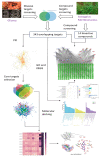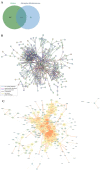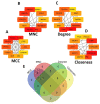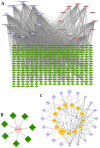A Network Pharmacology Prediction and Molecular Docking-Based Strategy to Explore the Potential Pharmacological Mechanism of Astragalus membranaceus for Glioma
- PMID: 38003496
- PMCID: PMC10671347
- DOI: 10.3390/ijms242216306
A Network Pharmacology Prediction and Molecular Docking-Based Strategy to Explore the Potential Pharmacological Mechanism of Astragalus membranaceus for Glioma
Abstract
Glioma treatment in traditional Chinese medicine has a lengthy history. Astragalus membranaceus, a traditional Chinese herb that is frequently utilized in therapeutic practice, is a component of many Traditional Chinese Medicine formulas that have been documented to have anti-glioma properties. Uncertainty persists regarding the molecular mechanism behind the therapeutic effects. Based on results from network pharmacology and molecular docking, we thoroughly identified the molecular pathways of Astragalus membranaceus' anti-glioma activities in this study. According to the findings of the enrichment analysis, 14 active compounds and 343 targets were eliminated from the screening process. These targets were mainly found in the pathways in cancer, neuroactive ligand-receptor interaction, protein phosphorylation, inflammatory response, positive regulation of phosphorylation, and inflammatory mediator regulation of Transient Receptor Potential (TRP) channels. The results of molecular docking showed that the active substances isoflavanone and 1,7-Dihydroxy-3,9-dimethoxy pterocarpene have strong binding affinities for the respective targets ESR2 and PTGS2. In accordance with the findings of our investigation, Astragalus membranaceus active compounds exhibit a multicomponent and multitarget synergistic therapeutic impact on glioma by actively targeting several targets in various pathways. Additionally, we propose that 1,7-Dihydroxy-3,9-dimethoxy pterocarpene and isoflavanone may be the main active ingredients in the therapy of glioma.
Keywords: Astragalus membranaceus; glioma; molecular docking; network pharmacology.
Conflict of interest statement
The authors declare no conflict of interest.
Figures











Similar articles
-
Based on network pharmacology and bioinformatics to analyze the mechanism of action of Astragalus membranaceus in the treatment of vitiligo and COVID-19.Sci Rep. 2023 Mar 8;13(1):3884. doi: 10.1038/s41598-023-29207-6. Sci Rep. 2023. PMID: 36890149 Free PMC article.
-
Integration of network pharmacology and molecular docking technology reveals the mechanism of the herbal pairing of Codonopsis Pilosula (Franch.) Nannf and Astragalus Membranaceus (Fisch.) Bge on chronic heart failure.Ann Palliat Med. 2021 Jul;10(7):7942-7959. doi: 10.21037/apm-21-1469. Ann Palliat Med. 2021. PMID: 34353081
-
Exploring the target and molecular mechanism of Astragalus membranaceus in the treatment of vascular cognitive impairment based on network pharmacology and molecular docking.Medicine (Baltimore). 2023 Mar 24;102(12):e33063. doi: 10.1097/MD.0000000000033063. Medicine (Baltimore). 2023. PMID: 36961195 Free PMC article.
-
An optimized herbal combination for the treatment of liver fibrosis: Hub genes, bioactive ingredients, and molecular mechanisms.J Ethnopharmacol. 2022 Oct 28;297:115567. doi: 10.1016/j.jep.2022.115567. Epub 2022 Jul 20. J Ethnopharmacol. 2022. PMID: 35870684 Review.
-
Biological active ingredients of traditional Chinese herb Astragalus membranaceus on treatment of diabetes: a systematic review.Mini Rev Med Chem. 2015;15(4):315-29. doi: 10.2174/1389557515666150227113431. Mini Rev Med Chem. 2015. PMID: 25723453 Review.
Cited by
-
Exploring the key pathogenic mechanisms and potential intervention targets for Sophorae Flavescentis radix in managing bone metastasis of lung cancer based on network pharmacology and molecular docking techniques.Transl Cancer Res. 2024 Oct 31;13(10):5616-5626. doi: 10.21037/tcr-24-1947. Epub 2024 Oct 29. Transl Cancer Res. 2024. PMID: 39524998 Free PMC article.
-
Curcumin ameliorates heatstroke-induced lung injury by activating the PI3K/AKT pathway.Naunyn Schmiedebergs Arch Pharmacol. 2024 Nov 9. doi: 10.1007/s00210-024-03572-z. Online ahead of print. Naunyn Schmiedebergs Arch Pharmacol. 2024. PMID: 39521756
-
A Phyto-mycotherapeutic Supplement, Namely Ganostile, as Effective Adjuvant in Brain Cancer Management: An In Vitro Study Using U251 Human Glioblastoma Cell Line.Int J Mol Sci. 2024 Jun 5;25(11):6204. doi: 10.3390/ijms25116204. Int J Mol Sci. 2024. PMID: 38892392 Free PMC article.
-
Hawthorn Proanthocyanidin Extract Inhibits Colorectal Carcinoma Metastasis by Targeting the Epithelial-Mesenchymal Transition Process and Wnt/β-Catenin Signaling Pathway.Foods. 2024 Apr 12;13(8):1171. doi: 10.3390/foods13081171. Foods. 2024. PMID: 38672844 Free PMC article.
-
Comprehensive analysis of the prognostic and immunological signature of TNFAIP8 family genes in human glioma.Sci Rep. 2024 Aug 2;14(1):17875. doi: 10.1038/s41598-024-68784-y. Sci Rep. 2024. PMID: 39090168 Free PMC article.
References
-
- Rock K., McArdle O., Forde P., Dunne M., Fitzpatrick D., O’Neill B., Faul C. A clinical review of treatment outcomes in glioblastoma multiforme–the validation in a non-trial population of the results of a randomised Phase III clinical trial: Has a more radical approach improved survival? Br. J. Radiol. 2012;85:e729–e733. doi: 10.1259/bjr/83796755. - DOI - PMC - PubMed
MeSH terms
Substances
Grants and funding
LinkOut - more resources
Full Text Sources
Research Materials

